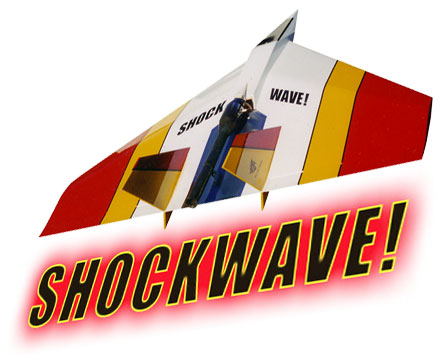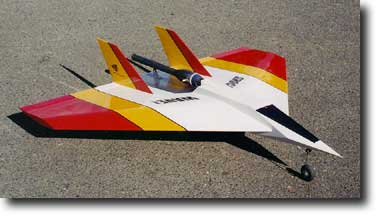
|
|

|
Designed by Bruce Tharpe
Built by Bruce and Bruce Sr.
Rogue River, Oregon
WINGSPAN
54 inches
WING AREA
1375 square inches
LENGTH
55 inches
WEIGHT
6-3/4 pounds (dry)
CONSTRUCTION
Balsa, Plywood, Spruce
Covered with Ultracote
CONTROLS
Elevons, Steering, Fuel Cutoff
|
|
This One Gets Right to the Point
My father and I built this model in about a month. The major design goals were to make it simple, big, light,
and aerobatic. Speed was not important to us. In fact, steps were taken to keep the speed down. It has fixed
tricycle landing gear with big wheels for smooth ground operation. The airfoil is a
thick, modified-diamond shape, mainly to make it easy to build flat on the building table. The top of the elevon
servos hang out in the breeze with short linkages to the control surfaces. The thinking was to make the model
large and somewhat "draggy", but still light enough
for good aerobatic performance. We've had fast models in the past, but much of their flying time is spent just
trying to keep them in sight. The Shockwave blasts around at about 90-100 mph, looping and rolling its way
through big maneuvers with no "specking out" during turn arounds.
 This model is the first one we built designed to use a bladder fuel tank. The fuel is carried in a latex
bladder which provides a steady pressure with no air bubbles. The methanol/notromethane blend is fed to a Cline
Proportional Control Fuel System before entering the engine. The Cline system uses a "demand regulator" which is
perfect for pulsejet operation. When the engine quits, the Cline regulator automatically shuts off fuel flow to
the hot engine.
This model is the first one we built designed to use a bladder fuel tank. The fuel is carried in a latex
bladder which provides a steady pressure with no air bubbles. The methanol/notromethane blend is fed to a Cline
Proportional Control Fuel System before entering the engine. The Cline system uses a "demand regulator" which is
perfect for pulsejet operation. When the engine quits, the Cline regulator automatically shuts off fuel flow to
the hot engine.
The engine on the Shockwave is a Bailey Sport Jet, made by Earl Bailey of Houston, Texas. You could call it a
Dynajet clone, but it's actually far superior. The machining is masterful, the welding on the tube is incredibly
smooth, and the operation is flawless. Notice the extra-wide aluminum heat shield on the top of the wing. I
thought someday we might add a second engine to the model, but it flies so good that we're going to leave it as
is.
In flight, the Shockwave does exactly what we wanted. It has a ton of wing area which gives it a light "feel",
even when loaded with 32-40 ounces of fuel. Delta wing structures are stout by nature, so I've been able to
crank this one around more violently than some of our other pulsejet models. When the engine quits, it settles
into a nice glide and caps off each flight with a slow, nose-high touch down.
Why such a pointy nose? I've always joked with my dad that I wanted to make sure that if it hits you, it will go
right through! Actually, it just seemed to fit the theme of the design with all its sharp corners and straight
lines. The black panel is a hatch for radio access.
 The Shockwave is not available as a kit, but plans are available from BTE. Click on the link under Resources for
complete info.
The Shockwave is not available as a kit, but plans are available from BTE. Click on the link under Resources for
complete info.
Shockwave and Delta Vortex

The BTE Delta Vortex is a successor to the Shockwave. The pulsejet-powered model flew so well, Bruce knew he had
to make one for a glow engine. The Delta Vortex is basically the same wing design with a smoother airfoil,
working rudders, a propeller, and (gasp!) throttle control.
|
|
|
|
|
|



